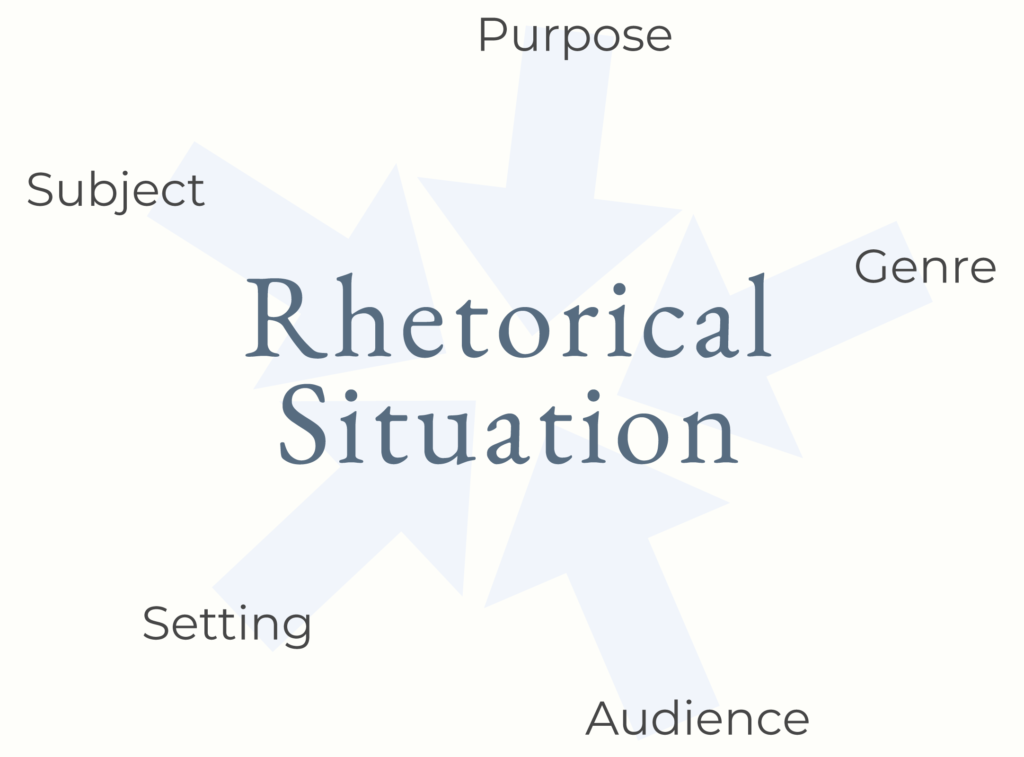17 Situate
Sarah Duffy
Explore the situation surrounding a source. Gain further insight by identifying its subject, genre, audience, purpose, and setting.
What You’ll Learn:
- Why situate a source
- How to situate a source
Consider this: Society changes over time. These changes make the views and laws of earlier generations seem outdated, only relevant in the context of their time and place in history.
Review the top statements below. Then, drag-and-drop each specific, outdated societal idea above its more current, updated version on the bottom.
Think about this: How does societal context impact an author’s views, opinions, and ways of expressing them? How important is it, when absorbing a source, to understand this context?
Why Situate

If you’ve already prepared and done a quick check (see Prepare, Pause, and Frame), you have a sense of the author’s background and know a little about when and where the source was published. This is an important first step. Now you’re ready to dig deeper into the source.
You should start by situating it, or placing it in a rhetorical context.
For example, imagine you are a student in 2040, reading an article written in 2020. To understand this article further, it would help to know more about the key contexts of the time. You’d find that the world in 2020 was in the midst of a global pandemic. This would help you understand the author’s choices and mindset at the time of writing the piece. It would also give insight into the outlook and attitude of its intended audience.
Or, perhaps, you’re reading a newspaper article in which an author expresses an opinion about fear of missing out (FOMO). The article was written in 2011. When you research further, you learn that iPhones were introduced in 2007, and social media platforms became more popular during the years after this. While the impact of social media is well known today, you find that the concerns of the author are insightful given its date of publication. You also gain a greater understanding of the observations and experiences shared by the author.
How to Situate
To situate a source, you should examine five elements: subject, genre, audience, purpose, and setting. By doing this, you consider why the source exists and determine how contextual factors led to its development and content.

Three sources are used as examples for “Rhetorical Context Defined.”
“Impacts of the COVID-19 Pandemic on Postsecondary Students” is a report from Statistics Canada published in May 2020. It is based on data collected from and about Canada and/or Canadians. You can find out more about Statistics Canada here.
“Pandemics Aren’t Wars” was published by Vox in April 2020 and was written by Alissa Wilkinson. Vox is a free online American publication that explains the news. You can find out more about the publication here.
“Most Common Panic-Buying Purchases During Coronavirus” was published by The Onion in May 2020. The Onion is an American satirical online publication that focuses on global and local news topics. You can learn more about the publication here.
| RHETORICAL | RHETORICAL CONTEXT DEFINED | |
|---|---|---|
| Subject | What is the topic of the source? | The subject should be captured in a specific short phrase. For example, in the case of the three sources listed above, the subjects would be “Impacts of COVID-19” (Statistics Canada report), “COVID-19 Compared to War” (Vox article by Alissa Wilkinson), or “COVID-19 and Purchasing Behaviour” (The Onion article). |
| Genre | What is the type of source? | There are many categories for both fiction and non-fiction. Non-fiction sources, the type most relevant to college students, include reports, essays, textbooks, reference books, biographies, and personal narratives. |
| Purpose | What was the author’s purpose in creating the source? | Generally, the purpose is described in one of three ways: to inform (e.g. the Statistics Canada report “Impacts of the COVID-19 Pandemic on Postsecondary Students”), to persuade (e.g. the opinion piece on Vox “Pandemics Aren’t Wars”), or to entertain (e.g. the satirical article published by The Onion “Most Common Panic-Buying Purchases During Coronavirus”). |
| Audience | Who are the intended readers or viewers of the source? | To determine the intended audience, you should look at: 1) the publication and its intended audience; and 2) the language used by the author—is it specialized (e.g. jargon for a specific professional audience), complex, formal, or informal? |
| Setting | What was happening—culturally, politically, socially—that may have influenced the author? | This requires a scan of factors that may have motivated the author. In all the above examples, the authors were influenced by the global COVID-19 pandemic and its extensive impact on day-to-day life. |
How Does Audience Influence Language?

As a communicator, you make choices about language all the time, and many of these choices depend on your audience.
Imagine this: You will miss class due to a doctor’s appointment and are concerned about getting caught up on the materials.
You text your friend this message:
hey im not going to be in class due to drs appt can you send pic of notes ttul
You email your professor this message:
Dear Prof. Gupta, Unfortunately, due to a medical appointment, I will have to miss your class today. If possible, could you post your notes so that I can review them tonight? Thank you, Sophie
Think about this: Although the purpose of these messages is similar—to advise someone that you are missing class and to make a request about class notes—the language choices are quite different. The personal message to a friend is written in informal language with short forms of words and no punctuation. The message to a professor is more formal, using correct sentence form.
All authors make intentional language choices when they consider their audience and purpose.
In the following example, we will explore the rhetorical context of a source.
Watch this: “The Amazon Belongs to Humanity—Let’s Protect It Together”
Now, learn more about this source in two steps:
Step 1: Do a quick check—find the author(s), publication, and publication date.
The quick check should be really fast. In less than a minute, you can find these details:
Authors – Tashka and Laura Yawanawá. Learn more here
Publication –Ted.com. Learn more here
Publication Date – September 2019
Step 2: Investigate the rhetorical situation.
When you have watched the video and done a little more searching, you’ll be able to identify its rhetorical situation:
Subject – protection of the Amazon
Genre – non-fiction, speech
Audience – viewers of TED Talks, general public since language is straightforward with no technical terms or jargon
Purpose – to persuade viewers that Indigenous people need to be heard; they have the answers to protecting the Amazon
Setting –
• “Indigenous peoples inhabit a large portion of the Amazon rainforest and their traditional and cultural beliefs have existed for centuries” (Lutz, n.d., para. 1)—read here
• in Brazil, 160 societies live within the Amazon (Lutz, n.d., para. 2)
one of the presenters, Tashka Yawanawá, is the chief of the Yawanawá people: “he leads 900 people stewarding 400,000 acres of Amazon rainforest in Brazil” (Skoll, n.d., para. 1)
• the threat to the Brazilian Amazon rainforest increased in January 2019 when Bolsonaro, Brazil’s president, “cut funds for the enforcement of Brazil’s strict environmental laws, leading Amazon deforestation to spike” (EcoWatch, 2020, para. 14)
• the video was published at a time of significant increase in forest fires in the Brazilian Amazon rainforest; “There were … 19,925 fire outbreaks in September [2019] in the Brazilian part of the rainforest … the numbers soared by 41% compared to the same period in 2018” (Ortiz, 2019, para. 5)
Try It!
Directions:
- Practise identifying rhetorical context for “It’s Time for ‘They’” and “You’ve Got to Find What You Love” by placing the following descriptors in the correct spot in the Rhetorical Context Chart.
- Compare your rhetorical context to the model.
“It’s Time for ‘They’” by Farhad Manjoo is a 2019 article from The New York Times. Read it here, find more about the author here, and learn about The New York Times here.
“You’ve Got to Find What You Love” by Steve Jobs is a 2005 commencement speech made at Stanford University. Read it here, watch it here, and find more about the author here.
In this subtopic, you’ve learned
- why it is important to explore the rhetorical context of a source;
- what should be considered as part of a source’s context; and
- how to situate a source.


When you are familiar with a source’s rhetorical context, you can situate it within the bigger picture, and are able to appreciate the source, its perspective, and its role, leading to greater understanding. You will later be able to analyze and critique it.